The original Casper mattress pioneered the online mattress trend, and the Puffy brand has since emerged as another major player in the bed-in-a-box market. The Casper and Puffy Cloud are both mattress heavyweights with a lot to offer.
How does anyone choose between the OG Casper and the Puffy Cloud? With the help of this mattress comparison, of course! We’ll cover all the similarities and differences between these two beds and clarify which mattress is the best fit for different types of sleepers.
Casper vs. Puffy
Product
Firmness
Score
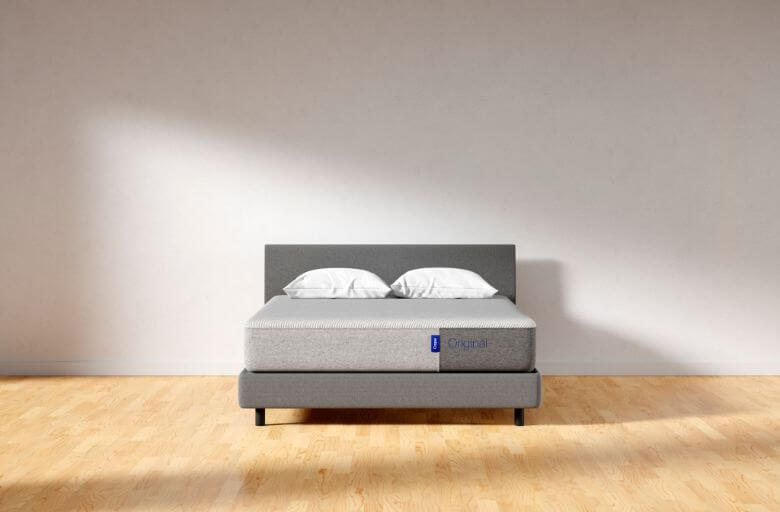
Product
Firmness
Score
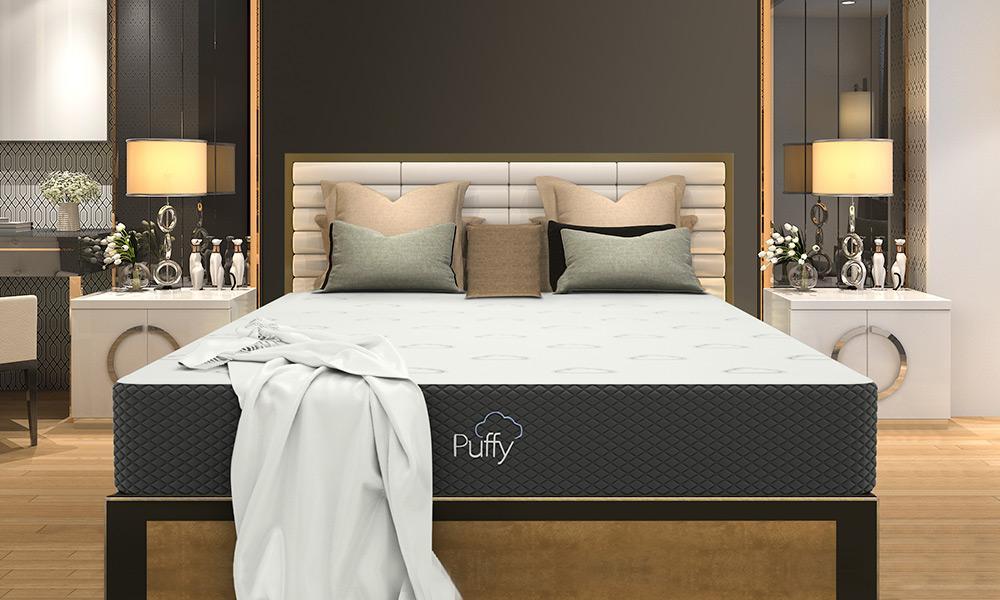
Product
Firmness
Score
Casper and Puffy Mattress Overview
The Casper and Puffy Cloud are both great mattresses that earned their popularity online. The versatile Casper features a proprietary Zoned Support system offering a blend of comfort and support, while the Puffy Cloud is an all-foam bed with a balanced foam feel.
Who Should Get The Casper?
- Combo sleepers who need a balance of comfort and support in multiple positions
- Back sleepers who require more lumbar support
- Sleepers who like a foam mattress with a bouncy, responsive feel
Read the full Casper mattress review
Who Should Get The Puffy Cloud?
- Light- and medium-weight side sleepers who don’t need a ton of comfort material
- Back sleepers who don’t need as much lumbar support
- Folks who want a balanced foam feel with a bit of memory foam on top
Read the full Puffy mattress review
Casper Vs Puffy Mattress Video Comparison
Take a closer look at each of these mattresses with the help of our in-depth video review. Our reviewer, Marten, will detail each bed’s construction and share his experiences with both mattresses.

Similarities Between the Casper and Puffy Cloud?
Both the Casper and Puffy Cloud are all-foam mattresses that are sold online, and the similarities don’t stop there. Here are a few other factors that these two beds share in common:
- Both the Casper and Puffy Cloud mattresses feature a similar base foam.
- The Casper and Puffy Cloud mattresses have a similar firmness.
- The beds are similar in terms of price, around $1,100 for a queen.
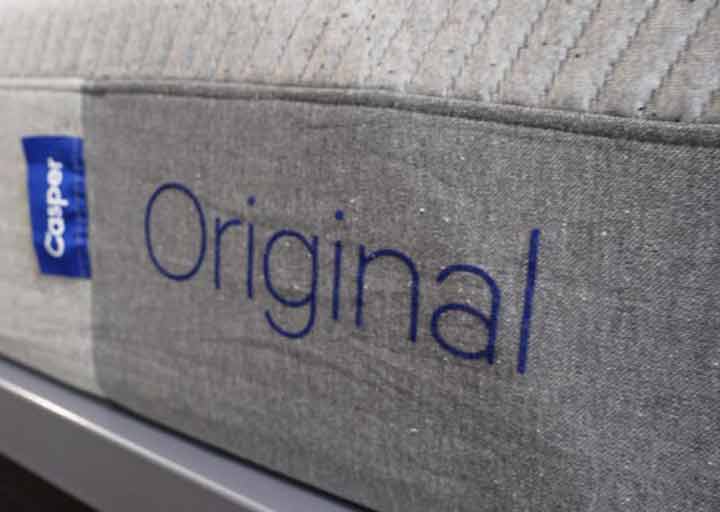
Key Differences Between the Casper and Puffy?
Even though the Casper and Puffy Cloud have some similarities, there are a lot of notable differences between these two beds.
- The Casper is about an inch thicker than the Puffy Cloud mattress.
- The beds use different types of foam in their top layers.
- The Casper features a Zoned Support system, while the Puffy Cloud mattress doesn’t.
- They have a slightly different feel. The Casper is a bit bouncier and more responsive, while Puffy Cloud has a slower response to pressure.
- The mattresses feature different cooling components. The Casper mattress uses AirScape foam to maximize breathability, while the Puffy Cloud has a gel infusion in its memory foam comfort layer to help the mattress sleep cooler.
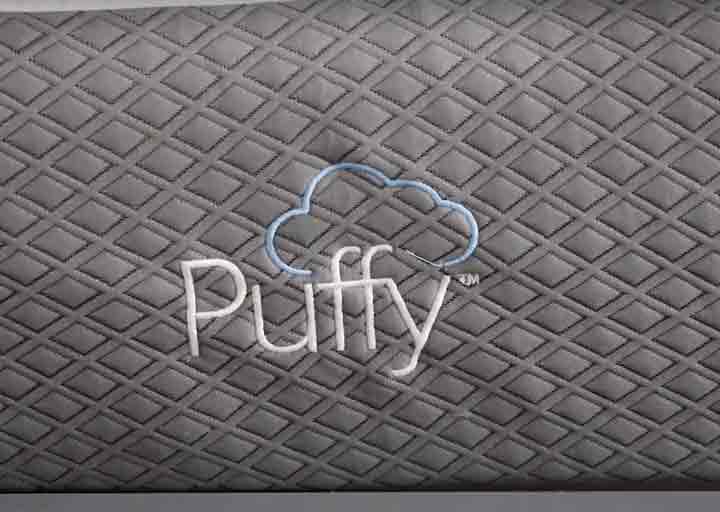
Firmness and Feel Differences
The commonalities and differences between the Casper and Puffy Cloud have a big impact on these beds’ firmness and feel. Let’s take a closer look at what it’s like to sleep on each mattress.
How Firm Are the Casper and Puffy Mattresses?
We ranked both the Casper and Puffy Cloud around a 7/10 on the firmness scale. The industry standard for medium firmness is 6.5, so both beds are a touch firmer than medium-firm.
It’s important to note that a person’s weight and size impacts their perception of a bed’s firmness. Different people might rank these mattresses’ firmness levels a bit differently.
Sleeping on the Casper and Puffy Mattresses
We slept on the Casper and Puffy mattresses to see how they feel for us in different positions.
Casper
We felt fantastic while back sleeping on the Casper. The bed allowed our hips to sink in, so it gave pressure relief without sacrificing spinal support. In particular, we felt great lumbar support when we were back sleeping on the Casper.
While side sleeping on the Casper, we just felt okay. We didn’t feel a ton of pressure relief, so this position might become uncomfortable for someone who spends all night on their side. That said, lighter-weight side sleepers will probably enjoy better pressure relief on the Casper mattress. Explore more beds for side sleepers here.
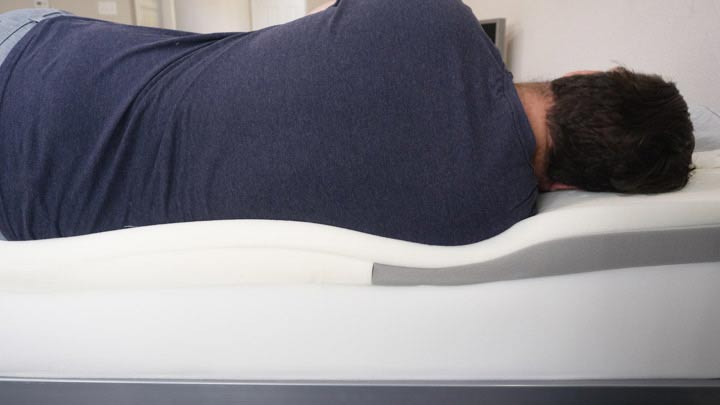
Moving to our stomach, we felt decent support from the Casper’s support layer. However, strict stomach sleepers might want to look for a firmer mattress with even more overall support.
Puffy Cloud
We felt a balance of comfort and support while back sleeping on the Puffy Cloud. This is ideal for back sleepers, especially folks who don’t require a significant amount of lumbar support.
While side sleeping on the Puffy Cloud, we did feel some pressure around the shoulder and hip. That said, lighter-weight people should enjoy better pressure relief while side sleeping on the Puffy Cloud.
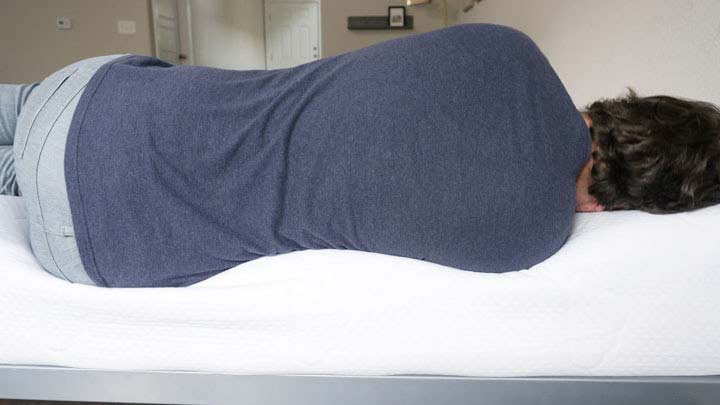
The Puffy Cloud felt a bit too soft for stomach sleeping. Our hips bowed into the mattress, throwing the spine out of alignment. Strict stomach sleepers will want to look for a firmer, more supportive mattress.
Change positions at night? Discover more mattresses for combination sleepers here.
What Do the Casper and Purple Mattresses Feel Like?
The Casper has a bouncy, responsive foam feel. During our bounce tests, the ball bounced up pretty high. This means it should be easy to move around on the Casper mattress without feeling stuck.
The Puffy Cloud has a balanced foam feel with a classic memory foam feel on top. The memory foam makes the Puffy a bit slower-moving than the Casper, but it’s not hard to move around on this mattress.
Average Weight Sleepers – 130 lb – 230 lb
The Casper should be a nice fit for average weight back sleepers because it offers a blend of comfort and support (especially lumbar support). Average weight side sleepers might feel more pressure than they’d like when lying on the Casper. It offers decent support for stomach sleepers, although people who spend all night in this position might want a firmer mattress.
The Puffy Cloud offers decent support for back sleepers, although there’s better lumbar support on the Casper mattress. Folks who are on the lighter end of the weight range (closer to 130 lb) could enjoy decent pressure relief while side sleeping on the Puffy Cloud. This is thanks to the memory foam on top. The Puffy Cloud isn’t supportive enough for average weight stomach sleepers, and they could feel their hips bowing into the mattress.
Heavyweight Sleepers – Over 230 lb
The Casper could be a good fit for heavyweight back sleepers who are close to 230 pounds because it offers nice lumbar support. Much heavier people will need a more supportive mattress (such as one with a coil construction). It’s not a great match for heavyweight side sleepers, who are likely to feel too much pressure around the shoulder and hip. The Casper could support heavyweight stomach sleepers who are close to 230 pounds, but it might not be supportive enough for heavier folks.
The Puffy Cloud might provide enough support to heavyweight back sleepers, but much heavier people will want to look for a more supportive mattress with coils. As with the Casper, the Puffy Cloud probably won’t offer enough pressure relief to heavyweight side sleepers. It’s also not a great fit for heavyweight stomach sleepers, who will likely find the Puffy Cloud too soft to offer adequate support in this position.
RELATED: Best Mattress For Heavy People
Lightweight Sleepers – Under 130 lb
The Casper mattress offers excellent lumbar support that should appeal to lightweight back sleepers. Even though the Casper is designed to be softer around the shoulders, lighter-weight side sleepers might not feel enough pressure relief. The Casper mattress should be supportive enough for lightweight stomach sleepers to enjoy healthy spinal alignment.
The Puffy Cloud offers decent support and comfort for lightweight back sleepers (although it won’t offer as much concentrated lumbar support as the Casper). The soft memory foam on top of the Puffy Cloud should let lightweight side sleepers enjoy decent pressure relief. The Puffy Cloud should be supportive enough for lightweight stomach sleepers to feel like their hips remain elevated and aligned with the spine.
Mattress Construction Differences
Let’s take a deeper dive into the Casper and Puffy Cloud. We’ll look closely at the materials in each mattress and assess how these materials might impact the beds’ overall feel and performance.
Cover
The Casper’s cover is made of recycled bottles and is very breathable, allowing for airflow. The Puffy Cloud features a thin, stretchy cover that’s also breathable.
Comfort Layers
The Casper’s top layer is made of Airscape foam, a plush, responsive, and breathable foam. Underneath the Airscape foam is the Casper’s main feature, the Zoned Support system. This is a foam layer that’s firmer near the center and softer near the head and foot of the mattress. The firmer section supports spinal alignment while back sleeping and stomach sleeping, and the softer sections create more pressure relief around the shoulders.
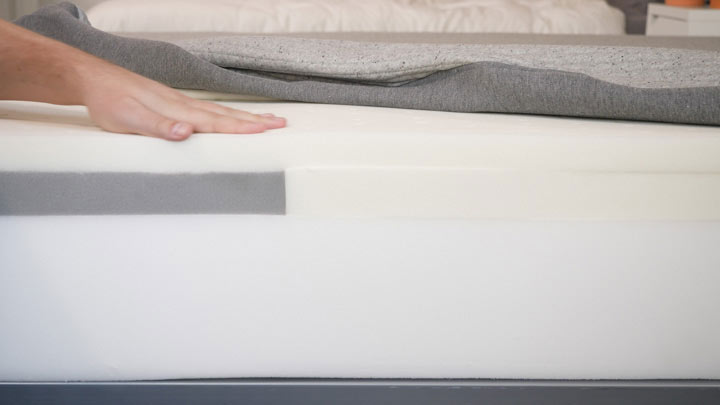
The Puffy Cloud’s primary comfort layer is made from Cooling Cloud memory foam, which has a slower-moving feel and is gel-infused to help with cooling. Below the Cooling Cloud layer, there’s a Climate Comfort layer that is firmer and more responsive. This adds some bounce to the mattress and also helps regulate temperature.
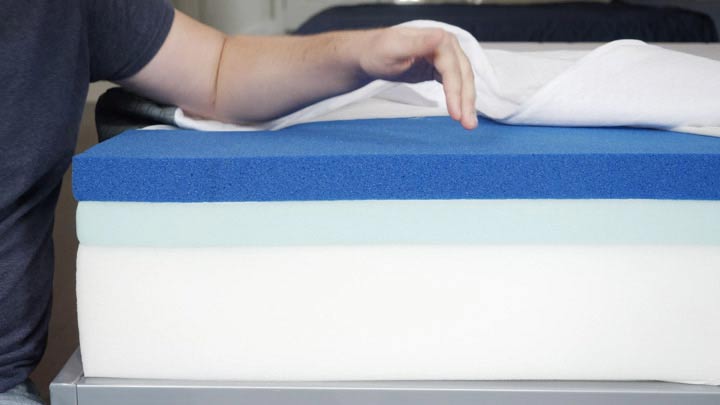
RELATED: Best Cooling Mattress
Support Layer
The Casper’s support layer features a sturdy base poly foam that gives structure and support to the entire mattress.
The Puffy Cloud’s Firm Core Support base layer is a firm-set foam layer that is unique to the Puffy Cloud. It’s firmer and more supportive than a lot of foam base layers, adding durability and structure to the mattress.
Mattress Height
The Casper is 11″ tall, while the Puffy Cloud is just a touch shorter at 10″ thick.
Casper and Puffy Mattress Size Options and Price
Check out these charts for the most up-to-date size and pricing information for both the Casper and Puffy Cloud.
Casper
| Size | Dimensions | Price |
| Twin | 39″ x 75″ | $895.00 |
| Twin XL | 39″ x 80″ | $995.00 |
| Full | 53″ x 75″ | $1195.00 |
| Queen | 60″ x 80″ | $1295.00 |
| King | 76″ x 80″ | $1695.00 |
| California King | 72″ x 84″ | $1695.00 |
Puffy Cloud
| Size | Dimensions | Price |
| Twin | 39″ x 75″ | $1949.00 |
| Twin XL | 38″ x 80″ | $2099.00 |
| Full | 54” x 75” | $2249.00 |
| Queen | 60″ x 80″ | $2399.00 |
| King | 76″ x 80″ | $2599.00 |
| California King | 72″ x 84″ | $2599.00 |
You may want to compare these mattress prices to other brands by reading our other popular Casper and Puffy comparisons like Casper vs Tempur-Pedic and Puffy vs. Purple.
Casper vs Puffy Performance Differences
We put the Casper and Puffy Cloud through a range of tests to see how they perform with regard to cooling, motion transfer, edge support, and more. Let’s see how these beds stack up.
Sleeping Hot Or Cold
Both mattresses are all-foam beds with cooling components, so we called this a tie. The Casper features a breathable AirScape foam to promote airflow throughout the mattress, while the Puffy Cloud’s gel infusion helps prevent overheating.
Motion Transfer
This is a pretty close call, but we’re giving the win to the Puffy Cloud. Its memory foam layer does a nice job of absorbing motion and preventing motion transfer across the bed. Because the Casper has a bouncier feel, it didn’t perform quite as well.
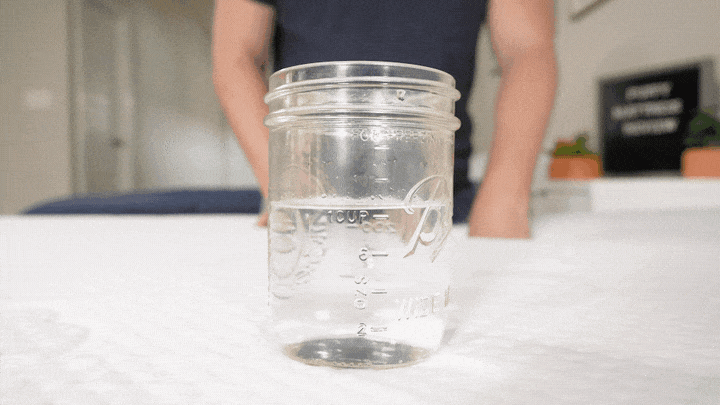
Edge Support
The win goes to Casper. Its Zoned Support system and firm base layer create a sturdier feel when sitting or standing near the edge.
Durability
The Casper and Puffy Cloud are both all-foam beds that should last for a similar amount of time (approximately 7 years).
Off-Gassing
Another tie! We found that the mattresses seemed to off-gas the same amount. Smells should dissipate within a couple of days.
Noise
The Casper and Puffy Cloud are pretty even here. Neither mattress made a significant amount of noise.
Sex
A mattress for sex should be responsive enough that nobody feels stuck in the bed. It’s also ideal if the mattress doesn’t make a ton of noise. Both the Casper and Puffy Cloud meet these criteria. Couples shouldn’t feel stuck in either mattress, and they won’t have to worry about squeaky springs on either bed.
Warranty Info
The Casper comes with a 10-year warranty and a 100-night sleep trial. The Puffy Cloud comes with a lifetime warranty and a 101-night sleep trial.
Casper and Puffy Mattress FAQs
Now, we would like to answer some of the most frequently asked questions about the Casper and Puffy Cloud mattresses.
Which mattress is better, Casper or Puffy?
Neither mattress is better than the other, but they could be better fits for different types of sleepers.
The Casper is a nice match for combo sleepers, back sleepers who need plenty of lumbar support, and sleepers who like a foam mattress with a bouncier feel.
The Puffy Cloud is well-suited to light- and medium-weight side sleepers, back sleepers who don’t need as much lumbar support, and folks who want a balanced foam feel with a bit of memory foam on top.
How long will the Casper and Puffy mattresses last?
All factors being equal, both of these all-foam beds should last for approximately 7 years.
Which mattress is better for side sleepers, Casper or Puffy?
The Puffy Cloud is better for light- and medium-weight side sleepers thanks to its memory foam comfort layer, which offers a touch more pressure relief than the Casper. Neither mattress is a great fit for heavyweight side sleepers.

